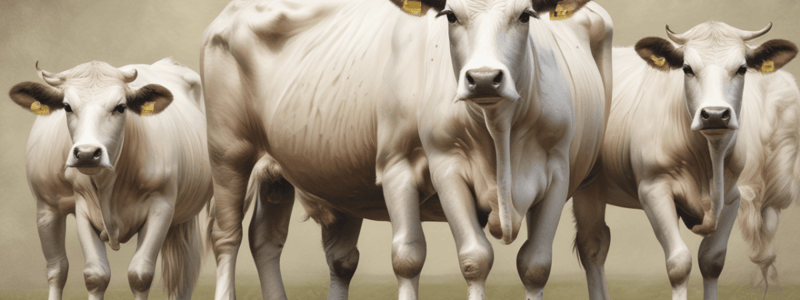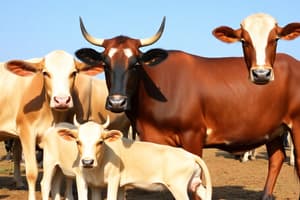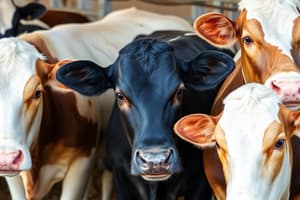Podcast
Questions and Answers
What general principle can be derived about milk pricing?
What general principle can be derived about milk pricing?
- There are no predictors for milk pricing.
- Only yield affects pricing decisions.
- Pricing is arbitrary and depends on the month.
- Quality indicators like protein and fat significantly impact pricing. (correct)
What impact does the High TBC have on the pricing?
What impact does the High TBC have on the pricing?
- It has a neutral effect on the price
- It only affects the VAT amount
- It reduces the price by -0.5c/l (correct)
- It increases the milk price
Which of the following statements describes the High SCC's impact on price?
Which of the following statements describes the High SCC's impact on price?
- It increases the milk price by 0.15c/l
- It has no impact on the total cost
- It decreases the price by -0.15c/l (correct)
- It affects only the payment received
Which term describes a female animal that has not yet calved?
Which term describes a female animal that has not yet calved?
What is the definition of a 'weanling' in dairy production terminology?
What is the definition of a 'weanling' in dairy production terminology?
Which breed is primarily recognized for its prolific milk production and is marked by its black and white coloration?
Which breed is primarily recognized for its prolific milk production and is marked by its black and white coloration?
What is a common characteristic of low-cost milk production systems in Ireland?
What is a common characteristic of low-cost milk production systems in Ireland?
Which of the following correctly identifies a steer?
Which of the following correctly identifies a steer?
Which breed is known for its red color and is a significant dairy breed in Norway?
Which breed is known for its red color and is a significant dairy breed in Norway?
What defines a cow in dairy farming terminology?
What defines a cow in dairy farming terminology?
A young animal that is between the ages of 12 months and 24 months is called a:
A young animal that is between the ages of 12 months and 24 months is called a:
Which breed is recognized for its small size and efficiency in milk production while often being raised in temperate climates?
Which breed is recognized for its small size and efficiency in milk production while often being raised in temperate climates?
What defines the Holstein-Fresian breed?
What defines the Holstein-Fresian breed?
What is the primary purpose of rearing heifer calves in a dairy herd?
What is the primary purpose of rearing heifer calves in a dairy herd?
What is the significance of colostrum in calf rearing?
What is the significance of colostrum in calf rearing?
Which nutrient is found in the highest percentage in colostrum compared to fresh milk?
Which nutrient is found in the highest percentage in colostrum compared to fresh milk?
Why is it recommended to provide a 'scratch factor' in the calf's diet?
Why is it recommended to provide a 'scratch factor' in the calf's diet?
What virus must calves be tested for to determine if they should be culled?
What virus must calves be tested for to determine if they should be culled?
At what point is a calf typically separated from its mother?
At what point is a calf typically separated from its mother?
What is the main benefit of 'grading up' the herd?
What is the main benefit of 'grading up' the herd?
What is the primary challenge faced by calves in digesting diets too early?
What is the primary challenge faced by calves in digesting diets too early?
Flashcards are hidden until you start studying
Study Notes
Dairy Cattle Breeds
- British Friesian: Known for high milk yield and adaptability to pasture.
- Holstein: Predominantly black and white, recognized for exceptional milk production levels.
- Holstein-Fresian: A variation emphasizing milk quantity while retaining some characteristics of the Holstein.
- Ayrshire: Originating from Ayrshire in Scotland, noted for efficiency in milk production from grass.
- Jersey: Small, cream-colored cattle prized for rich, high-butterfat milk.
- Kerry: A traditional breed from Ireland, known for its high milk yield and resilience.
- Montbéliarde: French breed, recognized for producing quality milk with good fat and protein content.
- Norwegian Red: Valued for milk quality and disease resistance; contributes to genetic diversity.
- Jersey x Holstein-Friesian: A crossbreed aiming to combine high yield and high butterfat content.
Dairy Terminology
- Calf: A young dairy animal up to 9 months old.
- Heifer: A young female that hasn't had a calf.
- Cow: A mature female that has calved.
- Bull: An uncastrated male bovine.
- Steer/Bullock: A castrated male bovine.
- Weanling: Animal aged between 9 months and a year.
- Yearling: An animal aged from 12 months onward.
Milk Production in Ireland
- Based on low-cost systems; milk primarily sourced from grass grazing.
- Milk prices are determined monthly, impacting farmer income.
Milk Price Scenarios
- Factors affecting milk price include protein and fat content, processing charges, and quality bonuses.
- Example Payment Structure:
- Farmer A (3.9% protein, 4.1% fat):
- Total milk price: 36.45c/l; earned €5,832.
- Farmer B (3.4% protein, 3.9% fat):
- Total milk price: 29.33c/l; earned €4,693.
- Farmer A (3.9% protein, 4.1% fat):
- Higher protein and fat content lead to increased prices per liter.
Calf Rearing
- Two main purposes: replacement heifers for dairy and fattening calves for beef.
- Early diet must account for undeveloped rumen in calves.
- Sequence of feeds after birth includes colostrum, fresh milk, powdered milk replacer, and gradual introduction of solid feeds.
Colostrum Benefits
- Colostrum contains critical nutrients and antibodies vital for calf health:
- Higher protein (14.9% vs. 3.2%) and fat (6.7% vs. 3-4%) compared to fresh milk.
- Vital immunoglobulins in colostrum provide passive immunity.
Health Management
- Bovine Viral Diarrhoea (BVD): A significant viral disease that requires identification and culling of affected animals.
- Effective housing should ensure sufficient space and hygiene for calf rearing.
Weaning Management
- Considerations for transitional feeding strategies as calves move off a milk diet.
Year 2 – Replacement Heifers
- Selection of heifers for herd replacement based on productivity and health of older cows.
- Grading Up: Enhancing herd genetics by replacing lower-yield cows with high-yielding heifers.
Studying That Suits You
Use AI to generate personalized quizzes and flashcards to suit your learning preferences.



